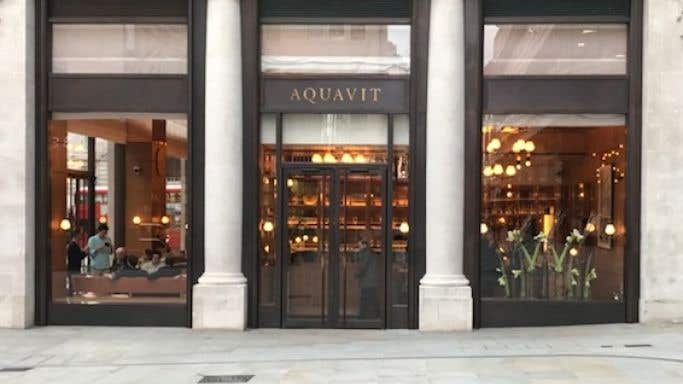The usually thin profile of Duncan Pitfield in the vicinity of a new, invariably large, restaurant is always a comforting sign to anyone who knows him.
So spotting Pitfield sitting alongside Philip Hamilton, Aquavit’s CEO, at the bar of Aquavit, the branch of the New York restaurant that specialises in Swedish cuisine and was initially opened by Marcus Samuelsson, and has just opened its London doors in the Crown Estate’s St James’s Market complex, came as a sign that this restaurant was in good hands.
Pitfield is a man who specialises in complex restaurant openings, principally for D&D restaurants, with whom he is in charge of half a dozen new UK restaurants in 2017. These include Aster in the Nova building by Victoria station, where Pitfield is working with executive chef Helena Puolakka, the combination that opened Skylon in the Royal Festival Hall; a couple of openings in Leeds; one at the top of the Spinningfields development in the centre of Manchester; as well as the second Bluebird café in the new BBC Television Centre in White City that is being redeveloped by Stanhope.
Des Gunewardena and David Loewi, the highly successful individuals behind D&D, also astutely allow Pitfield to take on the odd freelance project, hence his involvement with Aquavit, whose back story is almost as complicated as Pitfield’s.
The St James's Market is the Crown Estate’s redevelopment of a large block on the right-hand side as you walk up what is today called Regent Street (formerly Lower Regent Street) towards Piccadilly Circus. Windows proudly emblazoned ‘Established 1663 Reopened 2016’ will shortly house outposts of Paul & Shark and Smeg stores. Just before it is Carlton Street, on to which Aquavit faces with large windows and outside tables for when the sun shines.
This redevelopment is obviously of mixed use with retail and hospitality. As well as Aquavit, there is also Veneta, an Italian tapas restaurant from the Salt Yard group, and on the Haymarket the first London branch of Ole & Steen, one of Copenhagen’s favourite bakeries. And there are more large restaurants to follow.
Whether any will match Aquavit for the complexity of its history is difficult to imagine. This restaurant was opened in Manhattan 20 years ago by chef Marcus Samuelsson, the Ethiopian chef who wrote a fine book about growing up in Sweden, but is now under the culinary helm of chef Emma Bengtsson. Pitfield then went on to explain that Aquavit’s presence in London is down to a consortium of Hong Kong Chinese businessmen who see great value in the name and this particular style of Swedish cooking. There will, inevitably, be more Aquavits around the world.
The restaurant, designed as so many are in London at the moment by the studio of Swedish-born Martin Brudnizki, is light and bright and uses a lot of light wood that reflects not only Sweden but also the space’s natural daylight. I found a little too much bling in the accoutrements, the rather flash light fittings and on the backs of the chairs. It comprises 10,000 sq ft over three floors with a large production kitchen in the basement and two private dining rooms, for 14 and 60 respectively, on the first floor.
The menu, other than incorporating the desserts (and why does anybody want to see these at the start of their meal?), is clear and simple with a good use of colour and incorporates three main headings: smorgasbord and starters, both paired with aquavit selections, and main courses.
From the first we chose an excellent matje herring with potatoes, sour cream and egg yolk that came in a round metallic dish as well as a mackerel tartare with sorrel and lumpfish roe served in a bowl. These we followed by an admirably fresh piece of cod with shrimps, cucumber and dill, and monkfish with a Sandefjord sauce – a new one on me but apparently a Norwegian sauce of butter, cream and coriander that is named after the coastal city a couple of hours away from Oslo – with trout roe and fennel. The fish was a little on the dry side – perhaps because it was carved in two rather than being served as one whole piece as the cod was. With this we ordered the classic Swedish dish of Jansson’s temptation, cleverly served in a small copper pan and incorporating just the correct proportion of diced potatoes, onions and anchovies (nobody knows for sure who donated this recipe to the world but what a gift!) and some overcooked purple sprouting broccoli. Our bill came to £70 for two with coffee but no dessert.
The main courses also include some interesting accompaniments: brown butter and horseradish with the turbot; salt-baked onions with veal cheeks; lingonberries and pickled cucumber with the Swedish meatballs; and, perhaps most unusually, pickled beetroots and sorrel with a whole trout for two.
We left Aquavit not entirely unconvinced. This London outpost obviously lacks the culinary excitement that I first recognised in its original Manhattan location – although it has gone on to be awarded two Michelin stars since then – and it has none of the personal if slightly chaotic, but warm, atmosphere of Anna’s Place, the initial outpost of Swedish cooking in north London some readers may well remember from many years ago.
But it is very good to see Swedish cooking, and aquavit, finally gaining a real presence in central London, and broadening even further the range of food on offer here. Just after we had ordered, in came the unmistakable figure of Richard Turner, the broad, ever-smiling executive chef of the Hawksmoor group of restaurants, who said that this was fast becoming one of his favourite restaurants, that this was his third visit and had we ordered the crab dish, served with rye brioche and fennel? We hadn’t but we will do so.
Aquavit London 1 Carlton Street, London SW1Y 4QQ; tel +44 (0)20 7024 9848. Open seven days.

